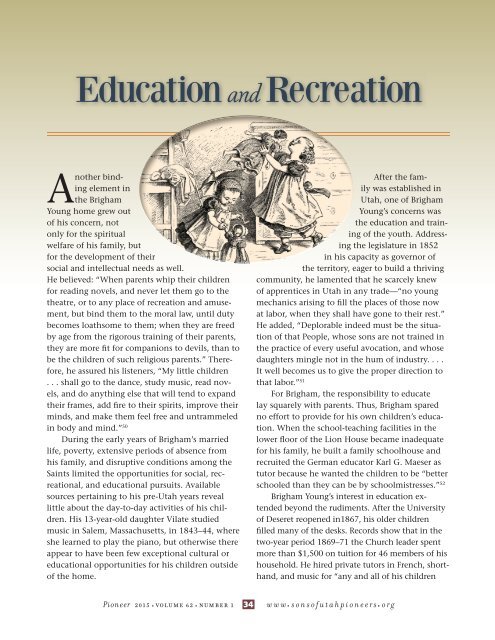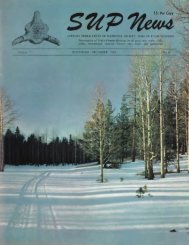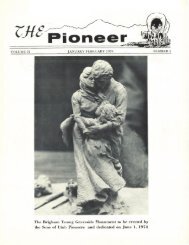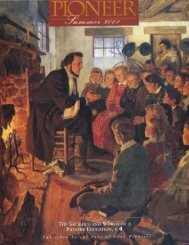Pioneer: 2015 Vol. 62 No.1
You also want an ePaper? Increase the reach of your titles
YUMPU automatically turns print PDFs into web optimized ePapers that Google loves.
Education and Recreation<br />
Another binding<br />
element in<br />
the Brigham<br />
Young home grew out<br />
of his concern, not<br />
only for the spiritual<br />
welfare of his family, but<br />
for the development of their<br />
social and intellectual needs as well.<br />
He believed: “When parents whip their children<br />
for reading novels, and never let them go to the<br />
theatre, or to any place of recreation and amusement,<br />
but bind them to the moral law, until duty<br />
becomes loathsome to them; when they are freed<br />
by age from the rigorous training of their parents,<br />
they are more fit for companions to devils, than to<br />
be the children of such religious parents.” Therefore,<br />
he assured his listeners, “My little children<br />
. . . shall go to the dance, study music, read novels,<br />
and do anything else that will tend to expand<br />
their frames, add fire to their spirits, improve their<br />
minds, and make them feel free and untrammeled<br />
in body and mind.” 50<br />
During the early years of Brigham’s married<br />
life, poverty, extensive periods of absence from<br />
his family, and disruptive conditions among the<br />
Saints limited the opportunities for social, recreational,<br />
and educational pursuits. Available<br />
sources pertaining to his pre-Utah years reveal<br />
little about the day-to-day activities of his children.<br />
His 13-year-old daughter Vilate studied<br />
music in Salem, Massachusetts, in 1843–44, where<br />
she learned to play the piano, but otherwise there<br />
appear to have been few exceptional cultural or<br />
educational opportunities for his children outside<br />
of the home.<br />
After the family<br />
was established in<br />
Utah, one of Brigham<br />
Young’s concerns was<br />
the education and training<br />
of the youth. Addressing<br />
the legislature in 1852<br />
in his capacity as governor of<br />
the territory, eager to build a thriving<br />
community, he lamented that he scarcely knew<br />
of apprentices in Utah in any trade—“no young<br />
mechanics arising to fill the places of those now<br />
at labor, when they shall have gone to their rest.”<br />
He added, “Deplorable indeed must be the situation<br />
of that People, whose sons are not trained in<br />
the practice of every useful avocation, and whose<br />
daughters mingle not in the hum of industry. . . .<br />
It well becomes us to give the proper direction to<br />
that labor.” 51<br />
For Brigham, the responsibility to educate<br />
lay squarely with parents. Thus, Brigham spared<br />
no effort to provide for his own children’s education.<br />
When the school-teaching facilities in the<br />
lower floor of the Lion House became inadequate<br />
for his family, he built a family schoolhouse and<br />
recruited the German educator Karl G. Maeser as<br />
tutor because he wanted the children to be “better<br />
schooled than they can be by schoolmistresses.” 52<br />
Brigham Young’s interest in education extended<br />
beyond the rudiments. After the University<br />
of Deseret reopened in1867, his older children<br />
filled many of the desks. Records show that in the<br />
two-year period 1869–71 the Church leader spent<br />
more than $1,500 on tuition for 46 members of his<br />
household. He hired private tutors in French, shorthand,<br />
and music for “any and all of his children<br />
<strong>Pioneer</strong> <strong>2015</strong> volume <strong>62</strong> number <br />
1<br />
34<br />
www<br />
<br />
sonsofutahpioneers<br />
<br />
org







